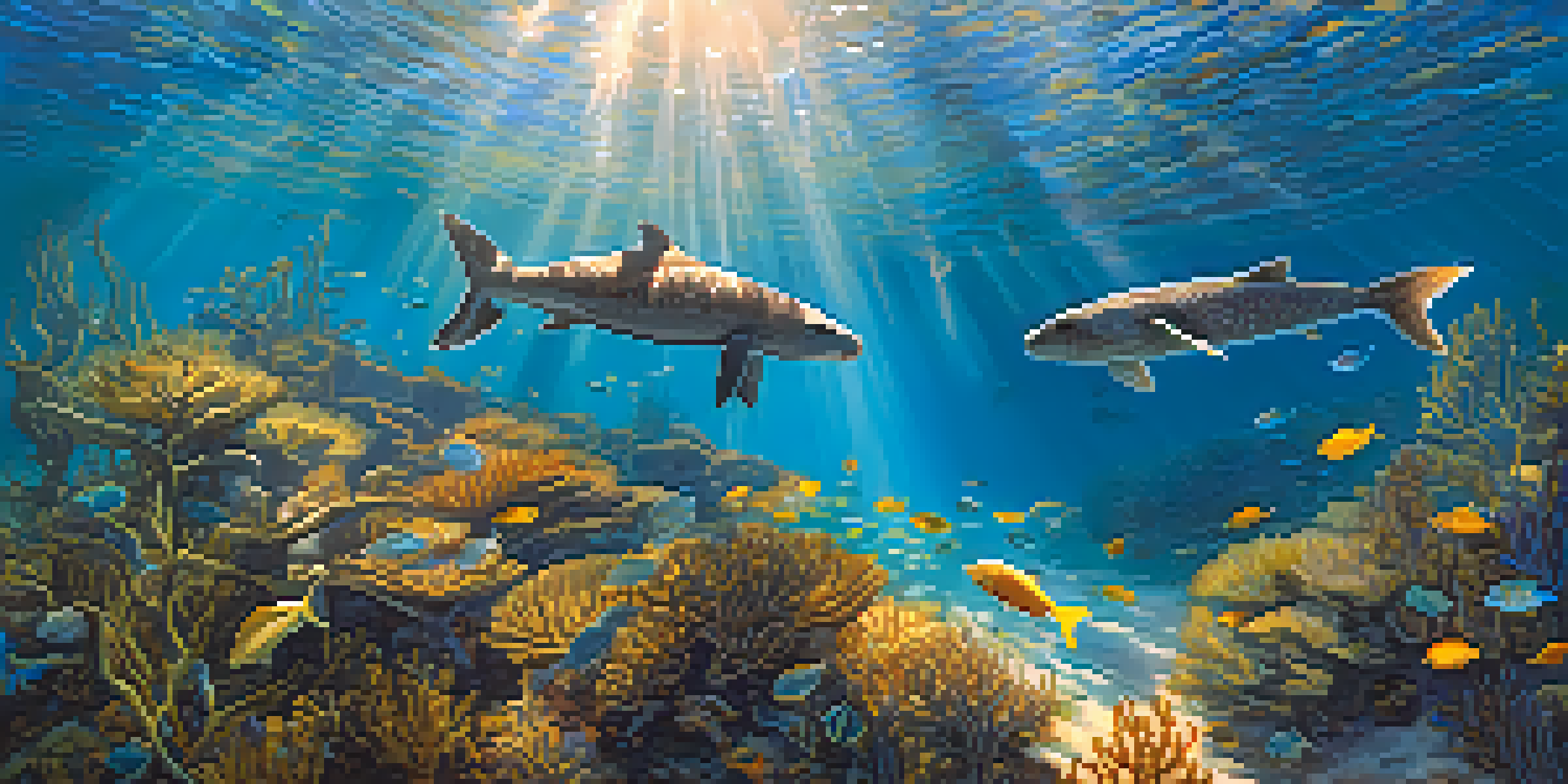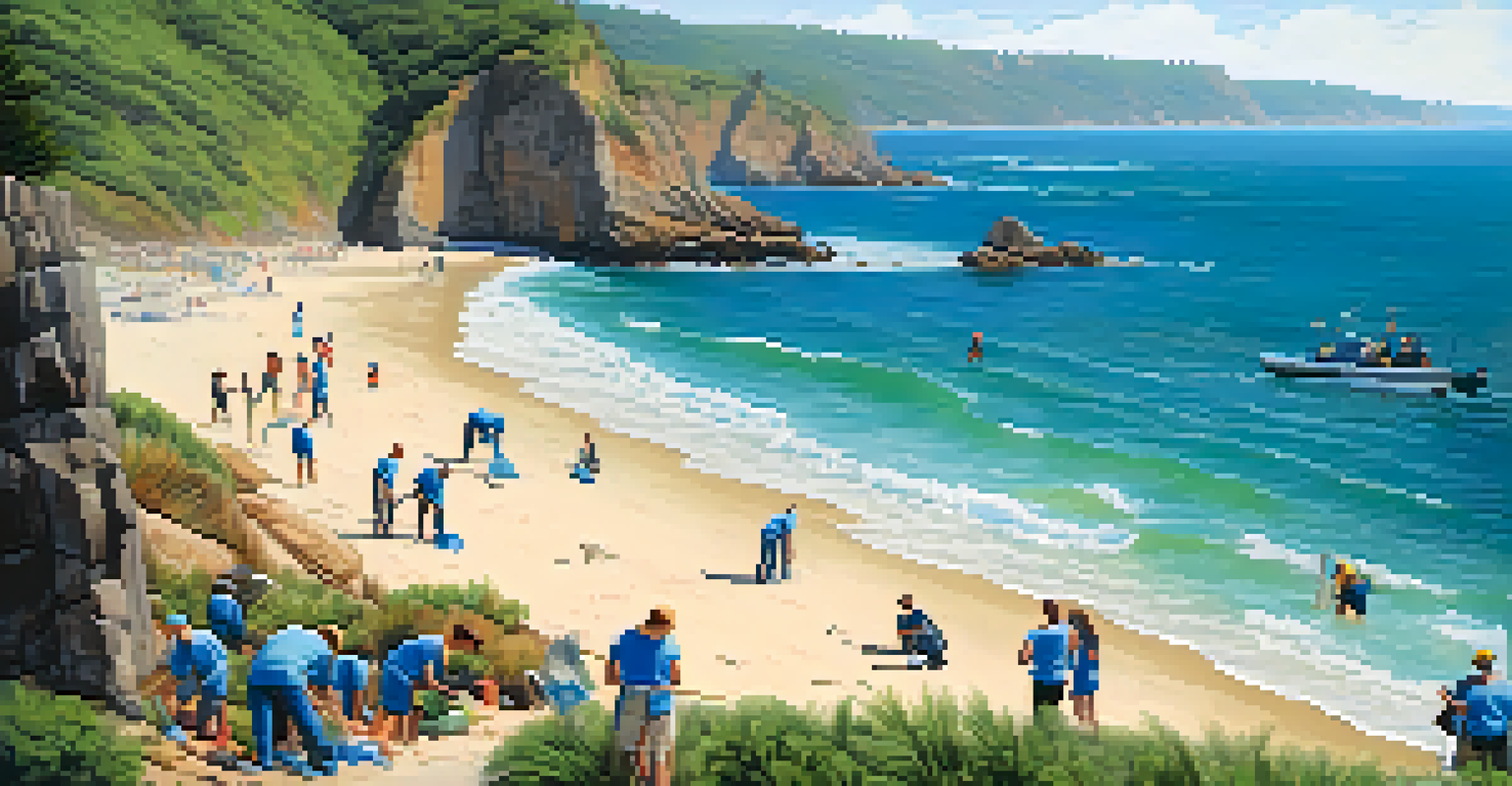California Marine Protected Areas: Safeguarding Ocean Life

Understanding Marine Protected Areas (MPAs) in California
Marine Protected Areas, or MPAs, are designated sections of ocean where human activities are regulated to conserve marine ecosystems. In California, these areas play a crucial role in protecting biodiversity and supporting the health of the ocean. By restricting activities like fishing and oil drilling, MPAs help ensure that marine species can thrive without excessive human interference.
The ocean is not just a place, it's a living, breathing entity that we are all a part of.
California boasts one of the largest networks of MPAs in the United States, encompassing over 850 square miles of ocean. This extensive system aims to balance ecological health with sustainable use of marine resources. It’s like creating a safe haven for marine life, allowing populations to recover and flourish in a protected environment.
The establishment of MPAs is not just about conservation; it involves collaboration among scientists, policymakers, and local communities. By engaging various stakeholders, California has created a model for effective marine management that can inspire other regions. Ultimately, MPAs serve as a vital tool in combating the challenges faced by our oceans.
The Importance of Biodiversity in Marine Ecosystems
Biodiversity refers to the variety of life forms within a given ecosystem, and it's essential for maintaining the health and resilience of marine environments. In California's coastal waters, a rich tapestry of species—from the smallest plankton to majestic whales—contributes to a balanced ecosystem. This diversity ensures that marine habitats can withstand changes and recover from disturbances.

For example, healthy kelp forests provide shelter and food for numerous marine species, playing a significant role in the overall ecosystem. When MPAs are established, these vital habitats can regenerate, allowing populations of fish and other organisms to rebound. This, in turn, benefits local fisheries and communities that rely on these resources.
MPAs Protect Marine Biodiversity
Marine Protected Areas (MPAs) in California play a vital role in conserving marine life by regulating human activities.
Moreover, a biodiverse ocean offers ecological services such as carbon sequestration and water purification, which are crucial in combating climate change. Protecting biodiversity through MPAs is not just about saving individual species; it’s about safeguarding the intricate web of life that sustains our planet.
Benefits of MPAs for Local Communities
While MPAs primarily aim to protect marine life, they also benefit local communities in various ways. By preserving fish populations and habitats, these areas contribute to the long-term sustainability of fisheries, ensuring that future generations can enjoy rich catches. This is especially important for coastal communities that rely heavily on fishing as a livelihood.
In every drop of water, there is a story of life.
Additionally, MPAs can enhance recreational opportunities, such as diving, snorkeling, and eco-tourism. Visitors flock to these protected areas to experience the beauty of marine life, which can boost local economies. It’s like a win-win scenario, where conservation efforts align with community interests.
Furthermore, MPAs promote environmental awareness and education. By engaging locals and visitors alike, these zones inspire a deeper appreciation for ocean conservation. This collective understanding can lead to more sustainable practices and a stronger commitment to protecting our oceans.
Challenges Facing California's Marine Protected Areas
Despite their importance, California's MPAs face several challenges that threaten their effectiveness. One significant issue is climate change, which impacts ocean temperatures, sea levels, and marine habitats. As the climate continues to change, species migration and habitat loss become pressing concerns.
Another challenge is ensuring compliance with regulations within these protected areas. Without proper enforcement, illegal fishing and other harmful activities can undermine conservation efforts. It’s akin to having a locked door but forgetting to close it—protection is only as strong as the commitment to uphold it.
Local Communities Benefit from MPAs
MPAs not only preserve marine ecosystems but also support local economies through sustainable fisheries and eco-tourism.
Additionally, there is often a need for ongoing research and monitoring to assess the health of these ecosystems. Understanding how MPAs are functioning in the face of environmental changes is crucial for adapting management strategies. Addressing these challenges requires a united effort from government, scientists, and local communities.
Monitoring and Research: Key to MPA Success
Monitoring and research are fundamental components of effective marine management. In California, scientists regularly assess the health of MPAs to understand how well they are achieving their conservation goals. This ongoing research provides valuable insights into species populations, habitat conditions, and the overall impact of the protected areas.
For example, studies have shown that MPAs can lead to increased fish populations and biodiversity over time. By comparing areas with and without protection, researchers can identify trends and make informed decisions about future management practices. It’s like a health check-up for the ocean, ensuring that it remains vibrant and resilient.
Moreover, involving local communities in monitoring efforts fosters a sense of stewardship. Citizen scientists can collect data and contribute to research, creating a shared responsibility for ocean health. This collaboration emphasizes that everyone has a role to play in protecting our marine resources.
The Future of Marine Conservation in California
Looking ahead, the future of California’s Marine Protected Areas hinges on continued commitment and innovation. As challenges like climate change and pollution intensify, adaptive management strategies will become essential. This means being flexible and willing to adjust regulations and practices as new information emerges.
Collaboration will also play a crucial role in shaping the future of MPAs. By fostering partnerships among government agencies, scientists, and local communities, California can create a more robust conservation framework. It’s about building a network of support that strengthens marine protection efforts.
Ongoing Research Ensures MPA Success
Continuous monitoring and research are essential for assessing the health of MPAs and adapting management strategies.
Ultimately, the success of California's MPAs will depend on a collective vision for the ocean's health. By prioritizing conservation and sustainable practices, we can ensure that future generations inherit vibrant and thriving marine ecosystems. Together, we can make a difference for our oceans.
How You Can Get Involved in Marine Conservation
Getting involved in marine conservation is easier than you might think! Whether you live near the coast or are visiting, there are plenty of ways to contribute to the health of our oceans. One simple step is to participate in local beach clean-ups, which help reduce pollution and protect marine habitats.
Another way to make a difference is by supporting organizations dedicated to marine conservation. Many groups focus on preserving MPAs, conducting research, and advocating for sustainable practices. Volunteering your time or donating can amplify their efforts and create a positive impact on ocean health.

Lastly, educating yourself and spreading awareness about the importance of marine conservation is crucial. By sharing information with friends and family, you can inspire others to take action. Remember, every small effort counts in the larger mission of safeguarding our oceans.